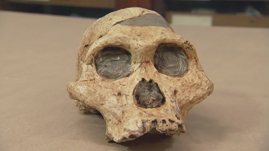Teachers' Domain - Digital Media for the Classroom and Professional Development
User: Preview

Source: The Human Spark: "Becoming Us"




Major funding for The Human Spark is provided by the National Science Foundation, and by the Alfred P. Sloan Foundation. Additional funding is provided by the John Templeton Foundation, the Cheryl and Philip Milstein Family, and The Winston Foundation.
ALAN ALDA (NARRATION) But the best place for me to start my search is not in France – it’s here in New York, at the American Museum of Natural History. I need some background on what Neanderthals and our ancestors had in common. The person I’m going to see is Ian Tattersall, the curator of anthropology and one of the world’s leading experts on human evolution. To get ready for my visit, Ian’s been unearthing some of our ancestors from the museum’s huge collection.
ALAN ALDA This is a wonderful room because it’s got all of these skulls that go back so far, but best of all it’s got what’s inside your skull. Because I could maybe get a little bit out of it from you.
IAN TATTERSALL Pick my brain, sure.
ALAN ALDA (NARRATION) We started with one of our earliest African ancestors.
IAN TATTERSALL This is an early hominid from South Africa dating to about 2 1/2 million years ago. It has a rather tiny brain case at the back but in contrast a very large face that’s hafted in front of the brain case. And then of course the history of hominids subsequently was to increase the size of the brain and decrease the size of the face.
ALAN ALDA (NARRATION) A half million years later, the skull of a more recent ancestor was looking distinctly more human.
IAN TATTERSALL And it’s about 1.8, 1.9 million years old and as you can see you have a significantly bigger brain case although only about half the size of our own brain case today, and in front of the brain case is a rather reduced face.
ALAN ALDA (NARRATION) With bigger brains came new abilities. One of the earliest and most enduring examples of our new-found skills was the invention, about 1.6 million years ago, of stone hand axes, probably used to butcher large animals.
Hundreds were found at this site in Kenya.
Once they were invented the basic design didn’t change, and people went on making them in Africa for over a million years.
JOHN SHEA What that tells me as a scientist, it tells me that tool is not under powerful natural selection. There’s nothing pushing the people to make different tools. It’s a tool that’s adequate to its task and they don’t need to change it. We have saying where I’m from, if it ain’t broke, you don’t fix it.
ALAN ALDA (NARRATION) John Shea is one of the leading experts on stone-age technology – and remarkably adept at creating stone tools using the same techniques as our ancestors. In real time a hand axe takes him about ten minutes.
It’s a pretty basic tool, yet our ancestors kept making it, generation after generation—for perhaps 50 thousand generations. In some ways it marks a very early sign of our brains’ new abilities. But in others, it also points out how far we still had to go.
Back at the American Museum of Natural History, Ian Tattersall is looking for the skull of one of these early toolmakers, and he can tell me where it fits in our evolutionary chain.
That is, if he can find it…
IAN TATTERSALL Here he is.
ALAN ALDA Got it?
IAN TATTERSALL Yeah, we got to be careful with this one.
ALAN ALDA Now who’s this?
IAN TATTERSALL This is a skull of Homo heidelbergensis from a site called Bodo in Ethiopia. It is dated to about 600,000 years ago, and it’s quite plausibly a member of the same general group, maybe the same species, that gave rise, on the one hand, later on in Africa to Homo sapiens, our own group. And in Europe, to the lineage that led to the Neanderthals.
ALAN ALDA It’s fun holding this guy, and having my hands on him, and thinking somebody like this gave rise to somebody like us. But at the same time, gave rise to a whole other group that didn’t seem to match up to us in many ways. Maybe critical ways, that sort of led to their demise.
ALAN ALDA (NARRATION) So Ian’s prize specimen lived at the beginning of a great divide in human evolution. One group of descendents stayed behind in Africa. But another group headed north, and over hundreds of thousands of years eventually made their way to Europe, where they evolved into what today we call the Neanderthals.
 Loading Standards
Loading Standards